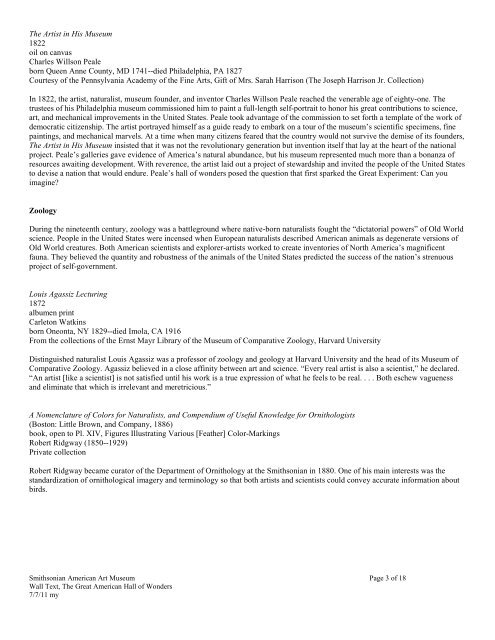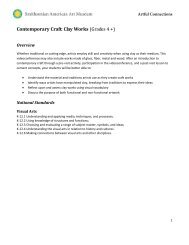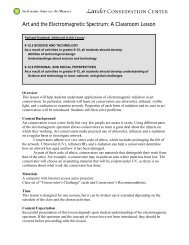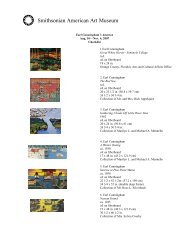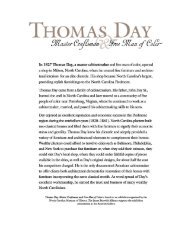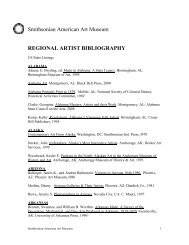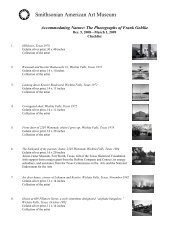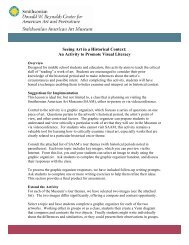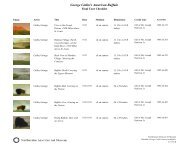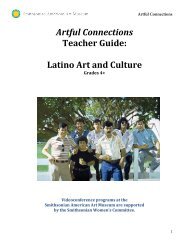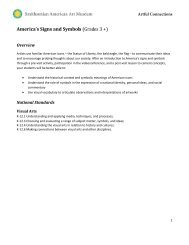Smithsonian American Art Museum - Smithsonian Institution
Smithsonian American Art Museum - Smithsonian Institution
Smithsonian American Art Museum - Smithsonian Institution
Create successful ePaper yourself
Turn your PDF publications into a flip-book with our unique Google optimized e-Paper software.
The <strong>Art</strong>ist in His <strong>Museum</strong><br />
1822<br />
oil on canvas<br />
Charles Willson Peale<br />
born Queen Anne County, MD 1741--died Philadelphia, PA 1827<br />
Courtesy of the Pennsylvania Academy of the Fine <strong>Art</strong>s, Gift of Mrs. Sarah Harrison (The Joseph Harrison Jr. Collection)<br />
In 1822, the artist, naturalist, museum founder, and inventor Charles Willson Peale reached the venerable age of eighty-one. The<br />
trustees of his Philadelphia museum commissioned him to paint a full-length self-portrait to honor his great contributions to science,<br />
art, and mechanical improvements in the United States. Peale took advantage of the commission to set forth a template of the work of<br />
democratic citizenship. The artist portrayed himself as a guide ready to embark on a tour of the museum’s scientific specimens, fine<br />
paintings, and mechanical marvels. At a time when many citizens feared that the country would not survive the demise of its founders,<br />
The <strong>Art</strong>ist in His <strong>Museum</strong> insisted that it was not the revolutionary generation but invention itself that lay at the heart of the national<br />
project. Peale’s galleries gave evidence of America’s natural abundance, but his museum represented much more than a bonanza of<br />
resources awaiting development. With reverence, the artist laid out a project of stewardship and invited the people of the United States<br />
to devise a nation that would endure. Peale’s hall of wonders posed the question that first sparked the Great Experiment: Can you<br />
imagine?<br />
Zoology<br />
During the nineteenth century, zoology was a battleground where native-born naturalists fought the “dictatorial powers” of Old World<br />
science. People in the United States were incensed when European naturalists described <strong>American</strong> animals as degenerate versions of<br />
Old World creatures. Both <strong>American</strong> scientists and explorer-artists worked to create inventories of North America’s magnificent<br />
fauna. They believed the quantity and robustness of the animals of the United States predicted the success of the nation’s strenuous<br />
project of self-government.<br />
Louis Agassiz Lecturing<br />
1872<br />
albumen print<br />
Carleton Watkins<br />
born Oneonta, NY 1829--died Imola, CA 1916<br />
From the collections of the Ernst Mayr Library of the <strong>Museum</strong> of Comparative Zoology, Harvard University<br />
Distinguished naturalist Louis Agassiz was a professor of zoology and geology at Harvard University and the head of its <strong>Museum</strong> of<br />
Comparative Zoology. Agassiz believed in a close affinity between art and science. “Every real artist is also a scientist,” he declared.<br />
“An artist [like a scientist] is not satisfied until his work is a true expression of what he feels to be real. . . . Both eschew vagueness<br />
and eliminate that which is irrelevant and meretricious.”<br />
A Nomenclature of Colors for Naturalists, and Compendium of Useful Knowledge for Ornithologists<br />
(Boston: Little Brown, and Company, 1886)<br />
book, open to Pl. XIV, Figures Illustrating Various [Feather] Color-Markings<br />
Robert Ridgway (1850--1929)<br />
Private collection<br />
Robert Ridgway became curator of the Department of Ornithology at the <strong>Smithsonian</strong> in 1880. One of his main interests was the<br />
standardization of ornithological imagery and terminology so that both artists and scientists could convey accurate information about<br />
birds.<br />
<strong>Smithsonian</strong> <strong>American</strong> <strong>Art</strong> <strong>Museum</strong> Page 3 of 18<br />
Wall Text, The Great <strong>American</strong> Hall of Wonders<br />
7/7/11 my


